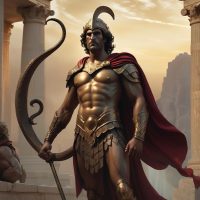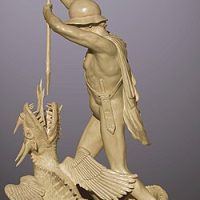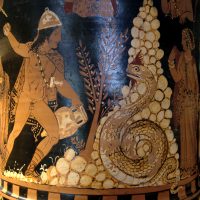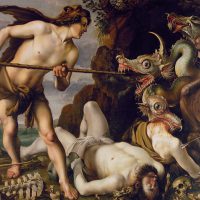Cadmus : The Dragon Slayer
Listen
At a glance
| Description | |
|---|---|
| Origin | Mediterranean Mythology |
| Classification | Mortals |
| Family Members | Agenor (Father), Telephassa (Mother), Europa, Phoenix, Cilix (Siblings), Harmonia (Wife), Polydorus, Semele, Ino, Agave, Autonoë, Illyrius (Children) |
| Region | Greece, Lebanon |
| Associated With | Bravery, Skill |
Cadmus
Introduction
Cadmus is one of the most significant heroes in Greek mythology, celebrated as the Phoenician prince who became the founder of Thebes, one of the great city-states of ancient Greece. His myth intertwines the cultures of the Near East and Greece, symbolizing a bridge of exchange, both cultural and linguistic. Often placed alongside pre-Herculean heroes such as Perseus and Bellerophon, Cadmus is remembered for slaying a dragon, sowing its teeth to give rise to the Spartoi, and for introducing the alphabet that would eventually shape Greek civilization. His life is a mixture of triumph and tragedy, reflecting the duality of human endeavor and divine fate.
Physical Traits
Ancient texts provide few specific details about Cadmus’s physical appearance, yet artistic traditions consistently depict him as a strong and noble warrior. Vase paintings and sculptures often show him in the act of slaying the dragon of Ares, presenting him as muscular, armed with spear or sword, and carrying himself with a heroic stature. Later myths describe his transformation into a serpent, symbolizing a shift from mortal hero to chthonic figure, representing wisdom, renewal, and the merging of human and divine. This metamorphosis encapsulates the theme of transformation that runs through his story, marking him not only as a man of action but also as one bound to deeper cosmic forces.
Family
Cadmus’s origins lie in Phoenicia, where he was born to King Agenor and Queen Telephassa. His siblings were Europa, who was famously abducted by Zeus, Phoenix, and Cilix. His journey to recover Europa became the catalyst for his destiny, ultimately leading him away from Phoenicia and toward the founding of Thebes.
Cadmus married Harmonia, the daughter of Ares and Aphrodite, in a marriage celebrated by all the gods. Their wedding was marked by divine gifts, the most notable being the cursed Necklace of Harmonia, crafted by Hephaestus. The couple had several children: Polydorus, who carried the Theban royal line forward, Semele, who became the mother of Dionysus, Ino, later transformed into a sea goddess, Agave, infamous for slaying her son Pentheus in a frenzy, and Autonoë, the mother of Actaeon. Another son, Illyrius, was remembered as the progenitor of the Illyrian people. Despite the grandeur of his lineage, tragedy seemed to haunt every generation, with the curse of Harmonia’s necklace casting a long shadow over their descendants.
Other names
The name Cadmus, written in Ancient Greek as Κάδμος (Kádmos), carries layered meanings. Scholars trace it to the Semitic root qdm, meaning “east,” reflecting his Phoenician origin and the cultural exchange between Greece and the Levant. Another interpretation suggests a Greek derivation from kekasmenos (κεκασμένος), meaning “excellent” or “distinguished.” These associations reinforce Cadmus’s identity as both an easterner who brought knowledge to Greece and a figure of excellence in myth. His descendants, the people of Thebes, were often referred to as “Cadmeans,” a name that linked the city directly to his legacy. In Illyria, his myth survived with adaptations, remembering him as both a culture-bringer and a founder.
Powers and Abilities
Cadmus’s powers were not those of a god but stemmed from his heroic lineage and divine favor. His skill in combat was legendary, most vividly displayed when he slew the dragon that guarded a sacred spring near Thebes. Following Athena’s guidance, he sowed the creature’s teeth in the earth, from which armed warriors sprang. These Spartoi, or “sown men,” fought until only a few remained, who later became the noble families of Thebes. This feat marked Cadmus not only as a warrior but also as a progenitor of civilization.
Beyond his martial prowess, Cadmus’s cultural contributions were profound. Ancient writers such as Herodotus credited him with bringing the Phoenician alphabet to Greece, a development that would lay the foundation for Greek literacy and, ultimately, Western writing systems. His marriage to Harmonia also underscored his divine favor, as few mortals received such honor from the gods. His final transformation into a serpent alongside Harmonia can be interpreted as a symbolic ability to transcend mortal existence, becoming part of the eternal cycle of life and death.
Modern Day Influence
The myth of Cadmus continues to shape modern thought, art, and culture. His association with the introduction of the alphabet underscores the enduring influence of cultural exchange between East and West, making him a symbolic figure in the history of literacy. The adaptation of the Phoenician script into the Greek alphabet and later into the Latin alphabet highlights his myth’s lasting impact on global communication.
In literature, Cadmus appears in works from Euripides to Ovid, and modern writers continue to revisit his tale as a metaphor for civilization’s triumphs and tragedies. Renaissance and Baroque artists, including Peter Paul Rubens, vividly depicted Cadmus’s battle with the dragon, using his story to illustrate themes of order overcoming chaos. In the 20th and 21st centuries, his myth has been reinterpreted in novels, academic works, and even popular culture. For example, DC Comics introduced “Project Cadmus,” a fictional scientific organization named after him, reflecting themes of creation, innovation, and sometimes hubris.
Archaeologically, the Cadmeia—the citadel of Thebes—remains a subject of study, linking myth and history through ruins that echo the legendary founder’s name. Scholars also continue to debate Cadmus’s origins, with arguments ranging from Phoenician to Mycenaean or Argive, underscoring the complex interplay between myth and cultural memory. His role as a bridge between different traditions ensures that his legacy is not just confined to ancient myth but is actively reinterpreted to explore ideas of identity, migration, and cultural exchange.
Even in popular imagination, Cadmus symbolizes the fusion of heroism, wisdom, and cultural transformation. His story highlights not only the struggles of a man navigating divine trials but also the broader journey of humanity, seeking knowledge, building civilizations, and wrestling with the consequences of both progress and fate.
Related Images
Source
Wikipedia contributors. (2025). Cadmus. Wikipedia. https://en.wikipedia.org/wiki/Cadmus
Encyclopaedia Britannica. (2023, April 14). Cadmus. https://www.britannica.com/topic/Cadmus
GreekMythology.com. (n.d.). Cadmus. https://www.greekmythology.com/Myths/Mortals/Cadmus/cadmus.html
Herodotus. (c. 440 BCE). Histories (Book V). Translated by A.D. Godley. Harvard University Press.
Graves, R. (1955). The Greek Myths. Penguin Books.
Hard, R. (2004). The Routledge Handbook of Greek Mythology. Routledge.
Burkert, W. (1985). Greek Religion: Archaic and Classical. Harvard University Press.
Fontenrose, J. (1980). Python: A Study of Delphic Myth and Its Origins. University of California Press.
Frequently Asked Questions
What is lorem Ipsum?
I am text block. Click edit button to change this text. Lorem ipsum dolor sit amet, consectetur adipiscing elit. Ut elit tellus, luctus nec ullamcorper mattis, pulvinar dapibus leo.
What is lorem Ipsum?
I am text block. Click edit button to change this text. Lorem ipsum dolor sit amet, consectetur adipiscing elit. Ut elit tellus, luctus nec ullamcorper mattis, pulvinar dapibus leo.
What is lorem Ipsum?
I am text block. Click edit button to change this text. Lorem ipsum dolor sit amet, consectetur adipiscing elit. Ut elit tellus, luctus nec ullamcorper mattis, pulvinar dapibus leo.
What is lorem Ipsum?
I am text block. Click edit button to change this text. Lorem ipsum dolor sit amet, consectetur adipiscing elit. Ut elit tellus, luctus nec ullamcorper mattis, pulvinar dapibus leo.
What is lorem Ipsum?
I am text block. Click edit button to change this text. Lorem ipsum dolor sit amet, consectetur adipiscing elit. Ut elit tellus, luctus nec ullamcorper mattis, pulvinar dapibus leo.











baseball bros io
This article on Cadmus is truly fascinating! I love how it weaves together his heroic deeds, like slaying the dragon, with his deeper mythological significance as a symbol of transformation and cultural exchange. The connection between his Phoenician origins and the introduction of the alphabet to Greece is particularly insightful, showing how mythology can reflect real historical developments. It’s also intriguing to see how his story has endured, inspiring everything from Renaissance art to modern comics. The mention of the curse of Harmonia adds a layer of tragedy that makes the myth even more compelling. Overall, it’s a well-researched and engaging piece that brings Cadmus’s legacy to life.
Free Nano Banana
This article on Cadmus is incredibly insightful and well-researched. I especially appreciated the detailed exploration of his origins, powers, and the lasting impact of his myth on various aspects of modern culture. The way the article connects Cadmuss story to themes of cultural exchange, heroism, and transformation is truly thought-provoking. Its fascinating to see how his tale continues to inspire and be reinterpreted in contemporary works, from literature to popular media. The inclusion of references to classical sources like Herodotus and modern interpretations like DC Comics Project Cadmus adds depth and context to the narrative. Overall, a comprehensive and engaging overview of this fascinating figure from Greek mythology.
Football
Wow, Cadmus’s story is such a wild ride! From slaying dragons to starting a whole civilization, it kinda makes you think about how our choices shape history, huh? Not to mention that cursed necklace, yikes! Seems like with great achievements comes a big ol’ helping of drama.